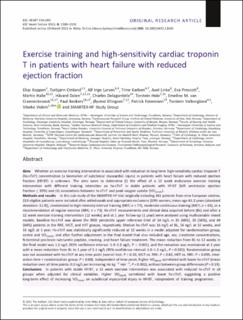| dc.description.abstract | Aims
Whether an exercise training intervention is associated with reduction in long-term high-sensitivity cardiac troponin T (hs-cTnT) concentration (a biomarker of subclinical myocardial injury) in patients with heart failure with reduced ejection fraction (HFrEF) is unknown. The aims were to determine (i) the effect of a 12 week endurance exercise training intervention with different training intensities on hs-cTnT in stable patients with HFrEF (left ventricular ejection fraction ≤ 35%) and (ii) associations between hs-cTnT and peak oxygen uptake (VO2peak).
Methods and results
In this sub-study of the SMARTEX-HF trial originally including 261 patients from nine European centres, 213 eligible patients were included after withdrawals and appropriate exclusions [19% women, mean age 61.2 years (standard deviation: 11.9)], randomized to high-intensity interval training (HIIT; n = 77), moderate continuous training (MCT; n = 63), or a recommendation of regular exercise (RRE; n = 73). Hs-cTnT measurements and clinical data acquired before (BL) and after a 12 week exercise training intervention (12 weeks) and at 1 year follow-up (1 year) were analysed using multivariable mixed models. Baseline hs-cTnT was above the 99th percentile upper reference limit of 14 ng/L in 35 (48%), 35 (56%), and 49 (64%) patients in the RRE, MCT, and HIIT groups, respectively. Median hs-cTnT was 16 ng/L at BL, 14 ng/L at 12 weeks, and 14 ng/L at 1 year. Hs-cTnT was statistically significantly reduced at 12 weeks in a model adjusted for randomization group, centre and VO2peak, and after further adjustment in the final model that also included age, sex, creatinine concentrations, N-terminal pro-brain natriuretic peptide, smoking, and heart failure treatment. The mean reduction from BL to 12 weeks in the final model was 1.1 ng/L (95% confidence interval: 1.0–1.2 ng/L, P < 0.001), and the reduction was maintained at 1 year with a mean reduction from BL to 1 year of 1.1 ng/L (95% confidence interval: 1.0–1.1 ng/L, P = 0.025). Randomization group was not associated with hs-cTnT at any time point (overall test: P = 0.20, MCT vs. RRE: P = 0.81, HIIT vs. RRE: P = 0.095, interaction time × randomization group: P = 0.88). Independent of time point, higher VO2peak correlated with lower hs-cTnT (mean reduction over all time points: 0.2 ng/L per increasing mL·kg−1·min−1, P = 0.002), without between-group differences (P = 0.19).
Conclusions
In patients with stable HFrEF, a 12 week exercise intervention was associated with reduced hs-cTnT in all groups when adjusted for clinical variables. Higher VO2peak correlated with lower hs-cTnT, suggesting a positive long-term effect of increasing VO2peak on subclinical myocardial injury in HFrEF, independent of training programme. | en_US |

